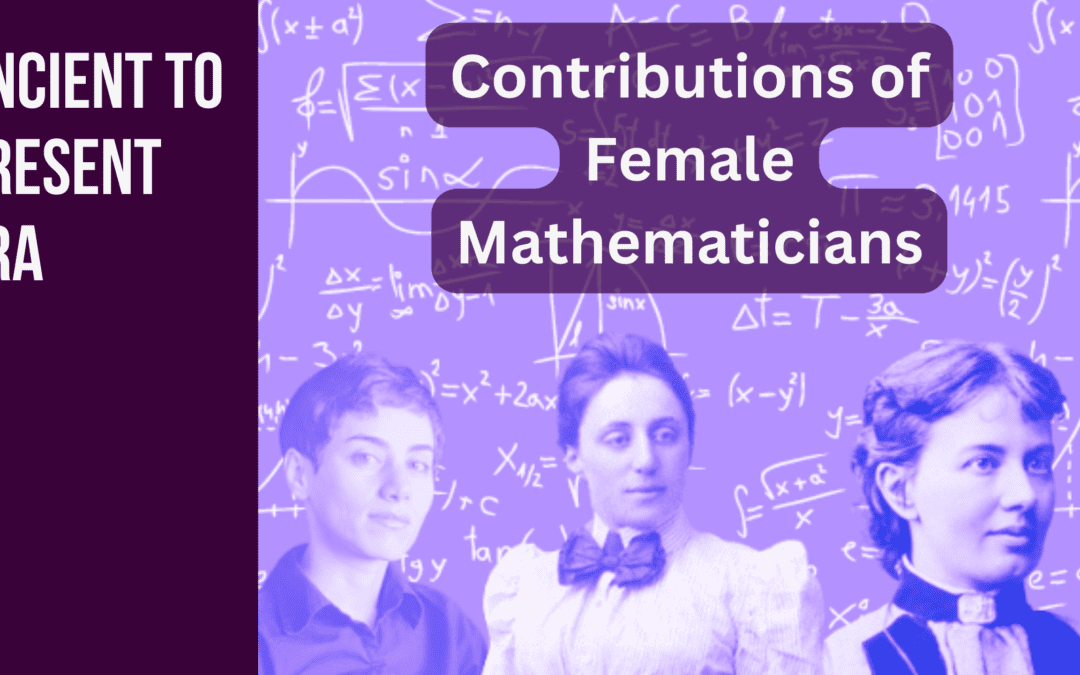Contributions of female Mathematicians: Why do women put less contribution than men?
In Mathematics, just 15% of tenure-track positions are taken by women, one of the lowest percentages in the fields of science, along with computer science (18%), and engineering (14%). Whereas mild fields of science tend to have more women in tenure-track positions, like psychology (55%) and biology (34 percent), etc. This reveals that the contributions of female Mathematicians are though qualitative but not that ample. Nature has granted equal intelligence, stamina, and endurance to both men and women then what are those aspects which have resulted in females putting fewer contributions in mathematics than males?
In the summer of 2019 in Brazil, four winners of Fields Medals were announced at the International Congress of Mathematics. The Medals, seen as the Nobel Prize in Mathematics, are awarded after every four years. Out of dozens of Mathematicians only two women, Maryna Viazovska from Ukraine, known for her work in the geometry of sphere-packing, and Sophie Morel, a French Mathematician who specializes in number theory were expected to win those medals but neither won; the medals were awarded to Peter Scholze, Alessio Figalli, Akshay Venkatesh and Caucher Birkar. There have now been 62 recipients of Fields Medals since they were first awarded in 1936. Of these, 61 have been men.
There is a common concept of “Gender Discrimination” which as per a big percentage of analysts is a major hurdle to soar up the work of women mathematicians. But actually, it’s not like that, Colva Roney-Dougal, Professor of Pure Maths at St Andrew’s University (UK), in her 18 years of research cannot think of any occasion when she was treated differently because of her gender. According to her, she has never felt uncomfortable being the only woman in the room. According to Julia Wolf, a reader in Pure Maths at Bristol University and a Professor of Pure Mathematics and Mathematical Statistics at the University of Cambridge, there are hardly any tangible obstacles to a women’s career in maths, but a lot of small things come together to make it more difficult for women to succeed. One of those “small” things that young male students seem to have, and young women don’t is the courage to take risks, and the confidence not to quit. When Wolf was an undergraduate at Cambridge, she had around 25% of women in the first year in maths. But in the third year, on courses that were considered difficult, she was the only girl left in her batch. All of the girls had disappeared to easier options. She found herself alone amongst dozens of men in a lecture about Hilbert spaces.”
I am myself teaching Mathematics since 2012. let me share the responses of my first-year Calculus students, when something is hard, the boys say, “It’s fine”, whereas girls say, “I don’t think I can do this“, yet there’s no difference in their ability.
The second thing that reduces women’s contribution to Mathematics is their family commitment, I have some female friends with family commitments who couldn’t do all that moving, so they gave up maths. We are losing many of our best female mathematicians, indeed, research in Europe, Asia & America that looked at the hiring of staff in maths-based faculties showed that women were more likely to be successful at interviews as compared to men. The problem was that fewer women applied for jobs in the first place.
Who was the first female mathematician?
Hypatia Of Alexandria (350A.D. to 470 A.D.)
Though ancient history has recorded a list of female Mathematicians, with respect to astounding contributions in the field of mathematics Hypatia’s name is on the top of the list, Hypatia of Alexandria, daughter of the great mathematician and philosopher, Theon of Alexandria, was born in 350 AD. She was a philosopher, mathematician, and astronomer. She took her training under the guidance of her father and became head of the Platonist school in 400 AD. In Alexandria, she taught mathematics and philosophy, precisely the teachings of Neoplatonism (the last Greek school of philosophy founded by Platonius). She believed in the spiritual aspect of mathematics and thought that numbers are the spiritual language of the universe. She divided mathematics into four branches, geometry, arithmetic, astronomy, and music. There is no evidence t that she did any new mathematical research, she however accompanied her father in creating a new version of Euclid’s Elements. She was the first female mathematician whose life was nicely recorded. Her commentaries on Apollonius’s Conics and Diophantus’s Arithmetica gave us evidence of her, carrying on the program initiated by her father into new and difficult areas.

Her commentary on Diophantus’s Arithmetica contained 100 mathematical problems solved using algebra. It was believed that only volumes I-VI of Arithmetica had survived and the rest are lost, but it is later found that four additional volumes were preserved in Arabic translation.
She also learned how to construct an astrolabe from her father, Theon wrote two books titled, Memoirs on the Little Astrolabe and another study on the Armillary sphere in Ptolemy’s Almagest. Hypatia and her father had studied Ptolemy’s Planisphaerium which contained necessary calculations for the construction of an astrolabe.
A few of her lost works are;
- A commentary on Archimedes’s Sphere and Cylinder surviving as John of Tynemouth’s De Curvis Superficibus, a text on isoperimetric figures incorporated by a later author into Introduction to the Almagest.
- A commentary on Archimedes’s Dimension of the Circle.
- A commentary edition of Apollonius Pergaeus’s Conics upon which later commentary editions were based.
- She also created an “Astronomical Canon”, which is believed to have been either a new edition of the Handy Tables by Alexandrian Ptolemy or a commentary on his book Almagest.
Her philosophical views made her the center point of the riots between Christians and non-Christians. As a result, she was brutally murdered by a mob of Christians in 415 A.D.
Contributions OF ancient female mathematicians
Theano (c.6th Century B.C.)
As per ancient history, Theano was the wife of Pythagoras. Some sources claim that she and her two daughters carried on the Pythagorean School after the death of Pythagoras and that she wrote treatises on mathematics, physics, medicine, and child psychology, her most important work was the principle of the “Golden Mean.”
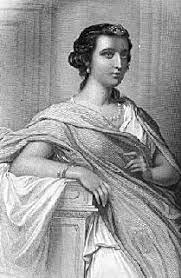
It is mentioned in the article in the Biographical Dictionary of Women in Science,
That Theano continued to operate the school of Pythagoras after his death is often affirmed but not confirmed. Thus, it can only be stated that, according to tradition, Theano was a mathematician, a physician, and an administrator—someone who kept alive an important training ground for future mathematicians
Themistoclea (c. 500 B.C.)
Themistoclea, was a priestess of Delphi, a well-known temple in Greece. She was the teacher of Pythagoras who had taught him ethics, geometry, and numerals. She distinguished herself among the women philosophers for her knowledge of mathematics and she taught inside the temple of Apollo in Delphi to whoever had the willingness to learn. According to the tradition she loved geometry so much that she decorated the Temple of Apollo with geometric shapes.

Pythagoras hold great respect for his teacher Themistoclea, that later on, he allowed women in his School as students and teachers as well. Although Themistoclea was well known during her time there is barely any information about her that has survived.
Damo (c. 500 B.C.)
Damo was the daughter of the philosopher and mathematician Pythagoras and his wife Theano, a marvelous blend of beauty and intellect, Damo was an exceptional philosopher and mathematician of her time.

She studied and then taught at her father’s school in the Greek city of Croton, and later moved to Athens, where she published some of Pythagoras’ work on geometry.
Contributions of European female mathematicians of the 18th and 19th centuries
Maria Gaetana Agenesi (1718-1799)
One of the most famous women in the history of Mathematics, Maria Gaetana Agnesi, born in Milan (Italy) was the first of 21 children, Her first publication was at the age of 9 when she wrote a Latin discourse defending higher education for women.

Her most important work was a New-Classic Calculus textbook published in 1748. Maria Agnesi is primarily remembered for a curve defined by the equation;
The curved was named “Versiera” (from the Italian word to turn) by Agnesi, but John Colson, an Englishman who translated her work confused the word Versiera with the word Avversiera which means ‘wife of the devil” in Italian, the curve has ever since been called “The Witch Of Agnesi”. This was particularly unfortunate because Colson wanted Agnesi’s work to serve as a model for young mathematicians, especially young women.
Florence Nightingale (1820-1910)
Florence Nightingale is famously known for her devoted service as a nurse in the Crimean War and her contribution towards the reform of sanitary conditions in military field hospitals. However, what is less known about this outstanding lady is her love of mathematics, especially statistics, and how this love played an important part in her life’s work.

Nightingale’s interest in mathematics extended beyond the subject matter. One of the people who also influenced Nightingale was the Belgian scientist Quetelet. He applied statistical methods to data from several fields, including statistics and social sciences.
Nightingale’s knowledge of mathematics became undeniable when she used her collected data to calculate the mortality rate in the hospital. These calculations showed that an improvement in the sanitary methods employed would result in a decrease in the death rate. Nightingale used this statistical data to create her Polar Area Diagram, or “coxcombs” as she called them.
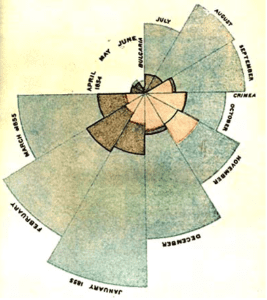
These were used to give a graphical representation of the mortality figures during the Crimean War (1854 – 56). In 1858, for her contributions to army and hospital statistics, Nightingale became the first woman to be elected to become a Fellow of the Royal Statistical Society. In 1874 she became an honorary member of the American Statistical Association and in 1883 Queen Victoria awarded Nightingale the Royal Red Cross for her work. She also became the first woman to receive the Order of Merit from Edward VII in 1907.
Sophie Germain (1776-1831)
Sophie Germain was one of the first women mathematicians of France to publish original mathematical research in number theory. In her time, women were not admitted to first-rate universities, so she wrote at first under the pseudonym Leblanc.

Even though Germain’s most important research was in number theory, she was awarded the prize of the French Academy for a paper entitled “Memoir on the vibrations of elastic plates.”
Ada Lovelace (1815-1852)
Ada Lovelace, known as the First Computer Programmer, was born on 10 December 1815 in London. At that time, formal education was quite unusual for women, that’s why Ada was put to home tuitions of Mathematics and Science at a very early age by her mother which enabled Ada in refining her skills for numbers.

The life-changing event that led Ada onto becoming a great mathematician and programmer was when she met Charles Babbage (the inventor of the first mechanical computer; the difference engine) in 1833 at the age of 17.
Charles Babbage later started working on another advanced masterpiece, the analytical engine. An Italian Engineer, Luigi Federico Menabrea had produced an article titled “Sketch of Charles Babbage’s Analytical Engine” for a Swiss journal. Ada translated it into English along with some additional notes on her own understanding and calculations for the working of the engine. Some of the things that she included in her notes and that allowed Ada to be known as the world’s first computer programmer include:
- The Bernoulli number algorithm
- A method through which the engine can repeat a series of instructions.
- Codes in the engine can lead it to work on not just numbers but also convert other disciplines like alphabets, music, etc. into numerical data.
Her notes were greatly acknowledged by Babbage and were published in an English science journal in 1843.
Sofia Kovalevskaya (1850-1891)
Russian mathematician and writer who put an exceptional contribution to the theory of partial differential equations. She was the first woman in 19th-century Europe to gain a doctorate in mathematics, the first to join the editorial board of a scientific journal and the first to be appointed professor of mathematics.
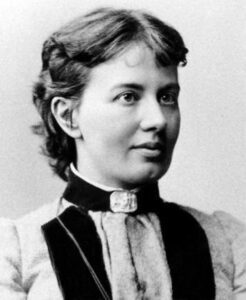
Sophia studied privately with the mathematician Karl Weierstrass. In 1874 she presented three papers on partial differential equations, Saturn’s rings, and elliptic integrals to the University of Göttingen as her doctoral dissertation and was awarded the degree, summa cum laude, in absentia. She won valuable recognition in the European mathematical community through her paper on partial differential equations. It contains what is now commonly known as the Cauchy-Kovalevskaya theorem, which gives conditions for the existence of solutions to a certain class of partial differential equations.
Contributions of Muslim female mathematicians of medieval times
Fatimah Al-Fihri (800 A.D. – 880 A.D)
Fatima Al-Fihri was born to a wealthy merchant family in modern-day Tunisia in 800 A.D. Al-Fihri used the vast inheritance left by her father to found the world’s first university, known as the Al-Qarawiyyin mosque. Though not much is known about Al-Fihri, she and her sister Maryam studied Islamic Jurisprudence and mathematics.
Al-Fihri’s contributions to mathematics education are recorded in the Rawd al-Qirtas (“The Garden of Pages”), the definitive history of Morocco written in Arabic in 1326 C.E by the 14th century historian Ibn Abi Zar.
Sutayta al-Mahamali (d. 987)
Sutaita was one of the most prominent mathematicians of Baghdad (Iraq) in the Golden period of Muslim civilization (Abbasid Caliphate). She worked on the theory of Algebraic equations (also known as hisab, or accounting in Arabic), and was considered an expert in inheritance formulas (successor calculations). Inheritance formulas were concerned with the distribution of a deceased individual’s estate to their relatives. The field was founded by Al-Kwarizhmi, and Sutaita was considered to be the most accurate and well-defined inheritance formulas of that time. She was also an influential legal scholar and made significant contributions to cubic equations.
Fatimah Al-Majritiya (d. 1008 C.E)
Fatima de Madrid, also known as Fatima Al-Majritya, was a Muslim astronomer and mathematician who made significant contributions to observational astronomy. She lived in Cordoba, Spain, an intellectual hub during the Islamic golden age. Fatimah along with her father worked on astronomical calendars, corrected the “Astronomical Tables of Al-Khwarizmi” (by transforming the Persian calendar to the Islamic calendar.), and determined the position of Celestial bodies such as the Sun, Moon, and planets.
Fatimah exercised with her father for her whole life on Astronomical and Mathematical discoveries. Perhaps Fatima’s most significant contribution to astronomy and mathematics is “the Corrections of Fatima“, which included amendments to her father’s discoveries, as well as updates to previous astronomical and mathematical discoveries. Fatima also coauthored “A Treatise on the Astrolabe”, a manuscript on an astronomical device used to determine the position of celestial bodies accurately. She also corrected Ptolemy’s Almagest, a treatise on the motions of the stars and planets, by fixing Ptolemy’s calculations of eclipses.
Lubana of Cordoba (d. 984 A.D.)
Born in Muslim Spain (Cordoba, Andulusia), Lubana was an exceptional copiest, librarian, and Mathematician during the Caliphate rule of Al-Hakam II. She worked with a Jewish scholar Hasdai Shaprut to establish Madinat al-Zahra, one of the richest libraries in Cordoba, which has more than 400,000 books where she specialized in books on Astronomy and Mathematics. Lubana also taught Mathematics to the public outside the palace.
Ibn Bashkuwāl, an influential 12th-century Andalusian biographer in Cordoba wrote:
“[Lubana was] an intelligent writer, grammarian, poetess, knowledgeable in arithmetic, comprehensive in her learning; none in the palace was as noble as she.”
Contributions of female mathematicians of the 21st century
Maryam Mirzhakani (1977-2017)
Marriam Mirzhakani, daughter of Iran, was one of the most exceptional geometry experts of the 21st century. She was the first woman to ever win the Fields Medal, the Nobel Prize for Mathematics. Her work in dynamical systems is beyond doubt one of the most remarkable contributions ever made by any female mathematician. She, in particular, worked on mathematical billiards, which consist of a point particle moving on a frictionless billiard table and hitting the sides of the table without losing momentum.
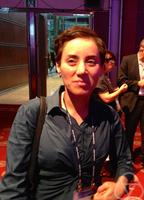
Marriam stunningly performed with manifolds too. A manifold is a surface that looks flat close-up but might be an entirely different surface when you zoom out and look from afar.
Mirzhkhani completed her undergraduate in mathematics at Sharif University in Tehran, Iran in 1999 and then went to Harvard for her PhD in Mathematics. In her doctoral thesis, Mirzhakani developed a formula that related the cardinality of the set of geodesics to their length. At Harvard, Mirzhakani developed an unexpected proof of an old conjecture posed by none other than Edward Witten, one of the foremost physicists of the 21st century. Mirzhakani’s dissertation resulted in three papers published in three of the most prestigious journals in mathematics: the Annals of Mathematics, Inventiones Mathematicae, and the Journal of the American Mathematical Society. According to Benson Farb, a mathematician at the University of Chicago notes;
“The majority of mathematicians will never produce something as good — and that’s what she did in her thesis.”
Roya Beheshti (1977-t0- present)
Roya Beheshti, a contemporary and school friend of Marriam Mirzakhani, is an Associate Professor of Mathematics at Washington University in St. Louis.

Roya proceeded to earn her Ph.D. in Mathematics from MIT. Her contribution as a mathematician is also standing tall, she completed her dissertation in 2003 on Lines of Fano Hyperspaces, and proved that “the Hilbert scheme of lines on any smooth Fano hypersurface of degree 6 or less has the expected dimension.” Roya subsequently became a senior mathematics researcher at the Max-Planck Institute in Germany and a postdoctoral fellow at Queen’s University in Canada and at UC Berkeley. In 2006, She became an Assistant Professor at Washington University in St. Louis.
Katherine Johnson (1918-2020)
Katherine Johnson, who served in NASA and its predecessor agency as a mathematician, passed away on 24 February 2020 at the age of 101. The recognition of Katherine’s mathematical contributions to aeronautics and to the USA’s space research is magnanimous. During World War II and the ensuing Cold War, National Advisory Committee for Aeronautics(NACA), NASA’s predecessor needed the skills of female mathematicians (“human computers”) to support the work of their engineers.

In 1959, she married Jim Johnson and published her first research report under the name Katherine G. Johnson, that report and her subsequent work in developing precise trajectory calculations for NASA’s early human spaceflights became indispensable in establishing the United States as the leading spacefaring nation. Electronic computers were just being introduced into the space program, and their results were not that accurate all the time. The human computers were crucial to keeping an aquiline vision on the machines. In the early 1960s, she worked on lunar orbits. Her contribution was undeniable in helping to realize President Kennedy’s goal of landing a man on the Moon.
In 2015 Katherine was awarded the Presidential Medal of Freedom by President Obama. In 2016 she received a Silver Snoopy Award from astronaut Leland Melvin and a NASA Group Achievement Award. In November 2019, by way of bipartisan legislation, Johnson and other hidden figures of NASA were honored with Congressional Gold Medals. Who can now doubt on the exquisiteness of the contributions of female mathematicians?
Valerie Thomas (1943-Present)
Valerie LaVerne Thomas, a scientist, mathematician, physicist, and inventor was born on February 1, 1943, in Baltimore (USA). At Morgan State College, well-known physics chair Julius Henry Taylor taught her trigonometry just in 20 minutes. NASA’s Goddard Space Flight Center (GSFC) hired Thomas as a mathematician/ data analyst in 1964 soon after she completed her graduation.
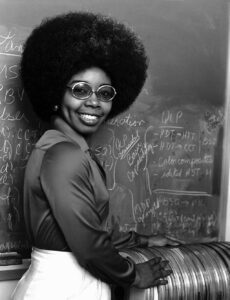
Valerie’s work is indeed a hallmark in contributions of female mathematicians, she developed computer data systems to support the Orbiting Geophysical Observatory (1964-1970); became an international Landsat image processing data format expert (1970-1981); and GSFC team leader for the Large Area Crop Inventory Experiment, which proved the feasibility of using Landsat data to predict global wheat yield. Dr. Thomas served as assistant program manager for Landsat/ Nimbus on detail at NASA Headquarters and technical officer for a $42 million multi-year technical support contract. In 1985, she was the National Space Science Data Center computer facility manager and served as project manager for the Space Physics Analysis Network (1986-1990), which was NASA’s wide area network and a critical part of today’s Internet. Her networking expertise contributed to the research on Halley’s comet, ozone hole studies, and a supernova.
Conclusion
Contributions of female mathematicians are though far lesser than male mathematicians but there is no reservation about the quality, uniqueness, and standard of their research work. Still, there are many women mathematicians so left to be covered in this article, the names of Marium Al-Asturlabi, Tahani Amer, Fatma Moalla, Emilie de Breteuil, Caroline Herschel, Emmy Noether, Dorothy Vaughn are worth mentioning. I must end up now with this assertion that it’s not the logical and analytical inability or gender segregation that holds back women to make adequate participation in mathematical research, it’s the lack of courage to take risks, less confidence not to quit, and family responsibilities.
Written by Maria Mehmood
Founder and Teacher My Maths Club

